Pakse & Champasak
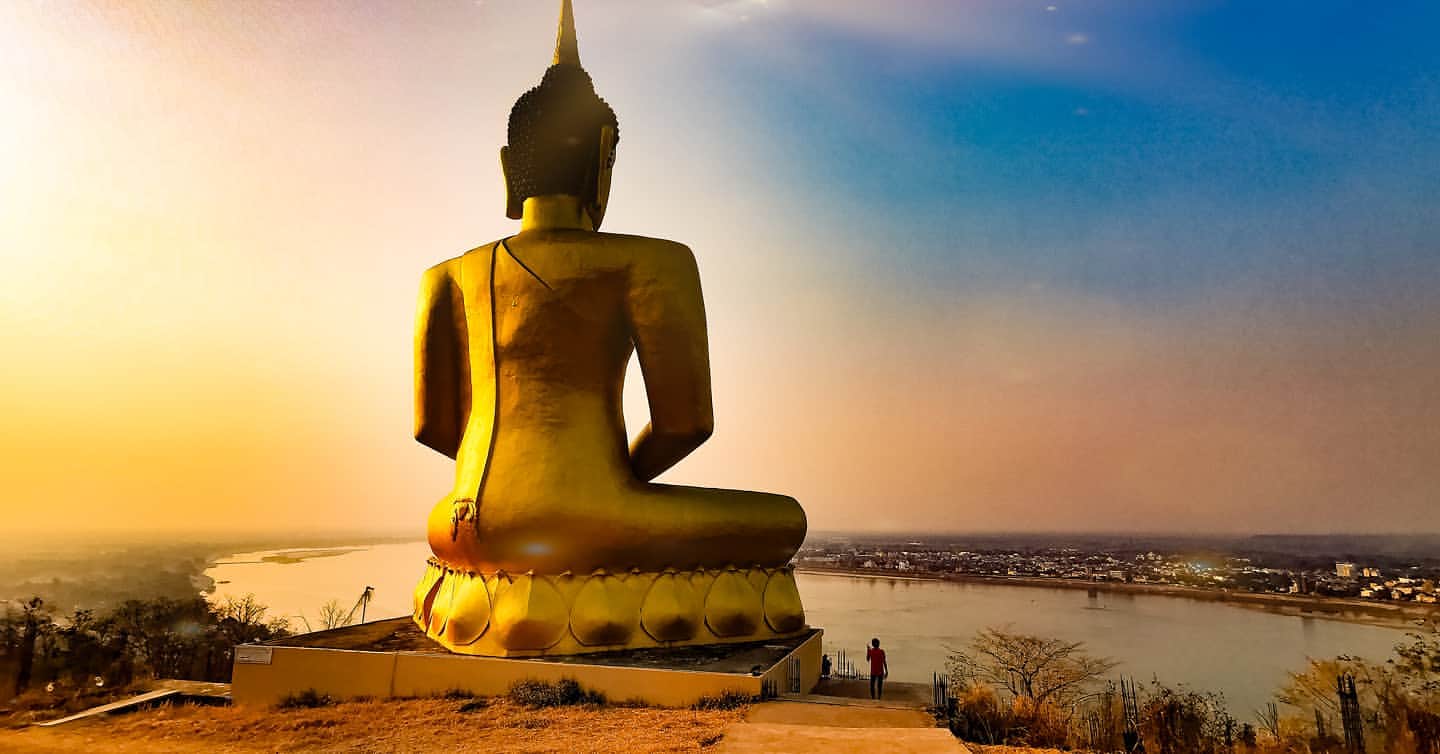
Pakse & Champasak
Champasak is a province in southwestern Laos, near the borders with Thailand and Cambodia. It is one of the three principalities that succeeded the Lao kingdom of Lan Xang. it had a population of 694,023. The capital is Pakse, but it takes its name from Champasak, the former capital of the Kingdom of Champasak.
Its cultural heritage includes ancient temple ruins and French colonial architecture. Champasak has some 20 wats (temples), such as Wat Phou, Wat Luang, and Wat Tham Fai. Freshwater dolphins and the province’s many waterfalls are tourist attractions.
There are many waterfalls in the province such as the Liphi Waterfall at Don Khon to the west of Ban Khon village. Below the falls in the calmer waters of the Mekong the fresh water dolphins can be seen. The Khone Phapheng Falls to the east of Don Khon, also on the Mekong, cascade along a broad mouth of rock slopes in a curvilinear pattern.
The economic output of the province consists primarily of agricultural products—especially production of coffee, tea, and rattan. It is one of the most important coffee producing areas of Laos along with Salavan and Sekong Provinces.
Pakse is the main trade and travel link with Thailand, Cambodia, and Vietnam.
Wat Phu Temple
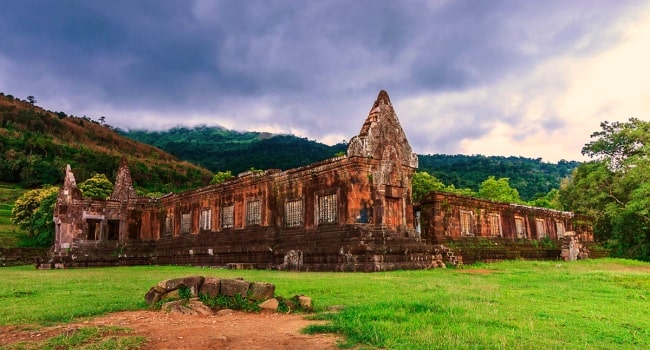
Wat Phu is the most important monumental complex inside the Champasak Archaeological Park, inscribed as a UNESCO World Heritage Site in 2003 and covering an area of 400 square kilometers. A maze of temples, shrines, and other monuments, Wat Phu is an emblem of the enduring genius of the human spirit.
The Wat Phu Temple complex is contained within the Champasak cultural landscape, a remarkably well preserved planned landscape more than 1,000 years old. It was designed to express the Hindu vision of the relationship between nature and humanity, using an axis from mountaintop to river bank to lay out a geometric pattern of temples, shrines and waterworks extending over some 10 km.
Structures of the temple complex
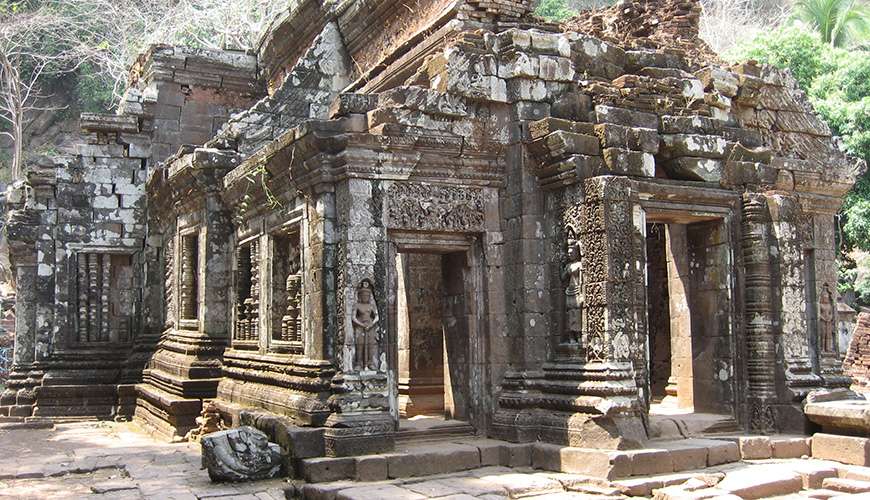
The various structures of the Wat Phou are built on seven terraces, aligned on an axis from the Mekong river bank towards the mountain. Starting at the river bank the visitor finds two large barays, a long processional walkway, two palaces and finally the main sanctuary.
The Khmer built several large barays, some of which are now dry. The barays are huge water reservoirs that symbolize the oceans surrounding Mount Meru, the center of Hindu mythology.
A long processional walkway with boundary markers on either side leads from the barays towards the main sanctuary. Halfway the walkway are the remains of two palaces, the Ho Thao South of the processional walkway and the Ho Nang to the North. Although called palaces, their function is not known with certainty. It is believed that the 11th century buildings were used during Hindu ceremonies. The lintels and pediments on the two large buildings are adorned with intricate carvings of Gods like Shiva and his consort Uma on Nandi, the sacred bull. Near the South palace is a shrine dedicated to the sacred bull Nandi, the mount of Shiva.
Between the palaces and the main sanctuary are the remains of several structures, including six small brick towers that used to contain a linga on the 4th terrace and a Dvarapala guardian on the second terrace.
Opening hours, The temple complex opens daily from 8 am until 4:30 pm.
Entrance fee: Admission is 60,000 Kip per person. A 70,000 Kip ticket includes a ride by golf kart to the entrance gate of the temple, less than 1 kilometer away.
Bolaven Plateau
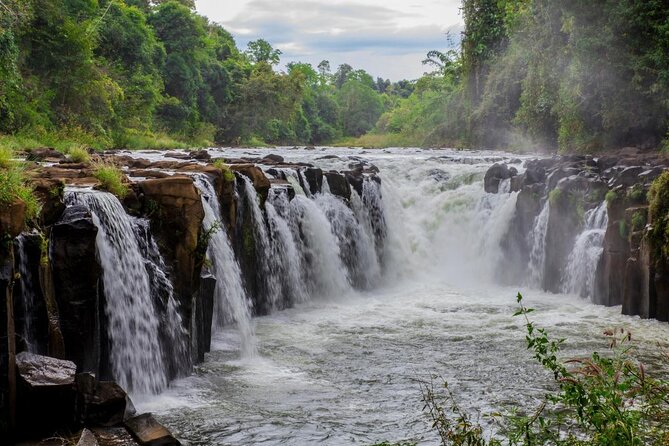
Just east of Pakse is the Bolaven Plateau. Here, the waterfalls are magic.
Tad Fan, also spelled Tad Fane, is found in the Dong Hua Sao National Park on the Bolaven Plateau, home to leopards, elephants, hornbills, and monkeys. The falls are located on the western side of the plateau and are are in an area surrounded by a rainforest and tea and coffee plantations – rumored to produce the best coffee in the country.
While it is not possible to swim near the falls, they can be viewed from across the gorge. For the more adventurous, one option allows travelers to view the falls by zipline, now considered the highlight of any trip to the Bolaven Plateau for those who can brave the heights and the hike.
There is a pathway with a number of lookouts, at the top, middle, and bottom of the gorge. The top of the falls hosts a picnic area and there is a small coffee plantation nearby that can be visited. The entrance to Tad Yuang is becoming quite developed and there are some restaurants and shops.
Tad Yuang
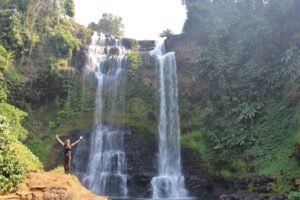
Ribbons of water plunge over a sheer cliff 40 metres to a pool below, the rising mist intensifying and electrifying the green hues of the surrounding jungle. It’s picture-perfect, an iconic dictionary definition of a waterfall.
Unlike taller Tad Fane, which is viewed from afar, the view to Tad Yuang is up close and personal. In dry season, it is possible to walk down and take a dip in the pool. Use extreme caution when walking on the stairs and pathway which are constantly slick and muddy from the mist.
Though the falls themselves remain untouched and natural, the entrance to Tad Yuang is quite developed, and it may be off putting for some.
Wat Phou Salao
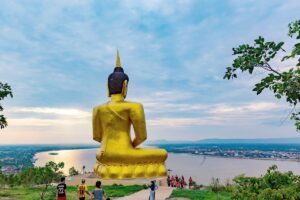
With a panoramic view of the surroundings, this hilltop temple just outside Pakse in the south of Laos is well known for its large Buddha statue which can be seen for miles around. The temple itself has rows of smaller golden Buddha statues as well as a much revered jade Buddha, but it is the giant golden Buddha that is the real draw. Looking out over the Mekong, the town of Pakse and as far as the Bolaven Plateau, the view from here is particularly delightful at sunset.
Dong Hua Sao National Protected Area
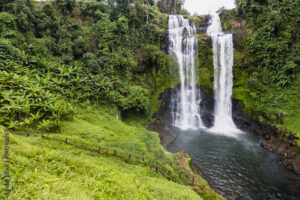
The protected area of Dong Hua Sao has great sustainable use of natural resources. It is one of the most visit ecotourism destinations. The park is in the Champasak are but, rises from the Mekong river lowlands eastwards into the Bolaven Plateau.
In the 50s the area wasn’t huge as today, with many ethnic minorities living there. With wartime, the minorities migrated to lowland areas. At the time coffee growing was introduced and in the 80s there was an establish coffee plantations.
In 1993 the area was renamed and covering the current area of 1,100 square kilometres. The habitat is a semi-dry evergreen forest. Some elevations in the area near the plateau can reach almost 1,300 meters.
Here you can spot the endangered yellow-cheeked gibbon, rare hornbills, giant butterflies and grey-faced tit-babbler. In the wetland is common to see green peafowl, Siamese crocodiles and hog deer.
Like most of the protected areas, the risk of environmental threats is high. Forest conservation for coffee plantations in number one. Destructive fishing practices, overcollection of forest products, hunting and use of the wetlands for agriculture and fishing are other treats.
In the Don Hua Sao National Protected Area, you can visit of the most stunning waterfall in Laos, the Tad Fane waterfall.
Dong Hua Sao National Protected Area can easily be accessed follow route 13 south and from Pakse-Paksong north.
Wat Luang Temple
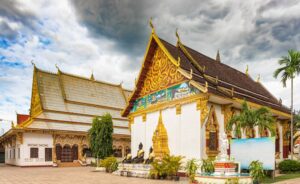
Wat Luang is located on the Se Don River near the bridge in Pakse in Laos. Wat Luang is probably the most important temple in Pakse.
Wat Luang is the main temple within the center of Pakse. It lies on the banks of the Se Don river just near the main bridge over the river and to the airport. The temple was established in 1935 and also serves as a Buddhist (sangha) colleges as well. The old building that houses the college is one of the more interesting in the temple compound. The carved plaster decorations are quite fanciful.
Wat Luang temple has a functioning school for monks; studies include courses in English, Business Management, and Cultural Studies. There is a library on the premises as well as magnificent river views. This Wat may accept foreign volunteers.
There are several funerary reliquaries lining the front of the compound. The largest of these houses the ashes of a former prime minister from pre-revolutionary times.
It has some wonderful paintings in the main temple which are been recently restored. Best to visit early morning or late afternoon when the sunlight catches the colours bes for some stunning photographs.
This Wat is just a short walk from the center of Pakse. Every morning at sunrise monks from Wat Luang walk past the river and collect their alms.
Behind the temple there is the Mekon River and the view is tremendous. People enjoy fishing, people commute by a small boat.
Wat Muang Kang
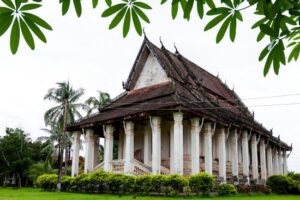
Dating to the 19th century, Wat Muang Kang (also known as Wat Phuthavanaram) is Champasak’s oldest active temple. With a lovely position on the banks of the Mekong river, the wat possesses a stunning blend of architectural styles. The crumble and patina of age only enhances its beauty.
Zip Lining at Tad Fane
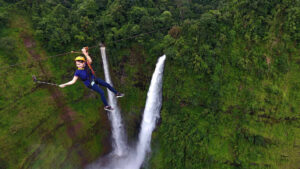
Tad Fane is the tallest waterfall in Laos, plunging 394 feet (120 meters) into the basin below. The visitor center is located across the gorge from the twin cascades and is well-developed with souvenir shops, cabins to rent, modern bathroom facilities and a coffee shop. For those who want to experience the falls from above, there is a zip line course that takes visitors across five lines in 30 minutes back and forth across the falls.
Xe Pian National Park
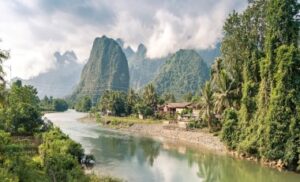
Xe Pian NPA (National Protected Area) in Champasak and Attapeu provinces, stretches east from the Mekong plain and south to the Cambodian border covering 240,000 hectares. This huge, remote NPA is unique in its habitat variety – 29 different ecosystem types, including globally endangered species of birds and mammals. The prime settings offers a rich and varied wildlife such as Asian Elephants, Sun Bears, Asiatic Black Bears, Sunda Pangolins and Smooth Coated Otters and Tigers. Xe Pian is a haven for bird watching and is home to great hornbills, and yellow-cheeked crested gibbons. There are numerous small villages of the Brau, Su and Lao Loum tribes, and visitors enjoy treks, elephant rides and homestays operated by local villages.
Wat Phabat
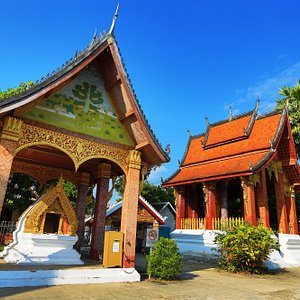
Another great Temple of Pakse is Wat Phabad, it is the oldest Buddhist temple in Pakse, the roadside 13 on the way to the Champasak Museum.
The temple Wat Phabad is visible and recognizable from the road by their colorful structures by way of small stupas. These structures are funerary monuments.
Champasak Provincial Museum
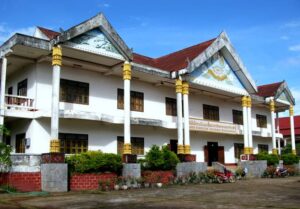
The Champasak Provincial Museum is a local museum in Pakse, Laos. It holds the unique history of the province, which gathers all kind of artifacts and documents to chronicle the history of Champasak. The museum also holds historical photos of cultural events, foreign meetings and pictures of Kaysone Phomvihane, Nouhak Phoumsavan and Khamtay Siphandone, all from the south. There are displays of musical instruments, stelae in the Tham script dating from the 15th to 18th centuries, a water jar from the 11th or 12th century and pottery from around the province and plus a model of Wat Phu. On the higher level, it displays different ethnic clothing, along with textile and jewellery collections.
